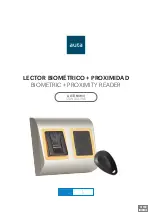
4. Optical System
2011-09
Instructions for Use for INFINITE M1000 PRO No. 30064852 Rev. No. 1.0
35
Excitation Spot Size
The size of the fiber bundle cross section determines the diameter of the beam
waist (spot size) in the microplate well. The
INFINITE M1000 PRO
can
automatically select between two available orifice diameters depending on the
type of microplate required.
For microplates up to 384 wells, a spot size of
about 2 mm is used. For microplates with 1536 wells, a spot size of 1 mm is
used.
Figure 13: Fluorescence Optics used for Top/Bottom Fluorescence intensity
measurement (the fiber details on the right hand side are shown for the bottom
measurement which is comparable to the top optics).
4.1.3 Fluorescence
Intensity
Detection
The fluorescence detection system is used for both measuring modes
fluorescence from above (top) and below the microplate wells (bottom).
The fluorescence light is focused onto the entrance slit of the emission
monochromator. After passing the monochromator, the light is focused onto the
detector (PMT: photo-multiplier tube, Figure 12). Between the monochromator
and the PMT a filter wheel is located (read below).
The Fluorescence Detection system is built from the following components:
1. Emission
Monochromator
2. Filter wheel PMT
3. PMT
Detector
Emission Monochromator
Similar to the excitation monochromator, the emission monochromator is used to
select any wavelength of the fluorescence signal. It acts like an adjustable filter in
wavelength and bandwidth to discriminate scatter of excitation light and
nonspecific fluorescence; therefore, to achieve maximum total fluorescence
signal, a broad excitation bandwidth should be used.
The bandwidth can be
selected from 5 nm to 20 nm in 1 nm steps.
















































